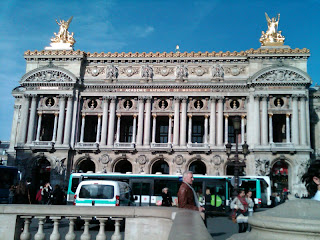I made a very grave error in my rundown of the 8th arr: I mentioned the area around the Opera as being part of the 8th, but in reality it's part of a little triangle of the 9th which juts into the 8th. Sorry!
Anyway moving on, about half of the 9th is very much like the 8th in appearance and attitude; that is to say, it's very upper class, with Haussman buildings, wide boulevards, and expensive shops. This is the area near the Opera and the big, chic department stores Printemps and Galeries Lafayettes.
The Opera (aka the Palais Garnier):
And a lovely picture, which is not mine, of the Galeries Lafayette from Christmas 2004:
It's big.
Anyway, heading north of this area a bit, it's still quite upper middle class, but more residential. It features the large but not hugely interesting church of Notre Dame de Lorette (not my picture):
and also, oddly enough, two of the main non-Marais synagogues (all of the following pictures are from Wikipedia - I have in face been in the Synagogue Buffault but pictures were frowned upon).
Firstly, the Grande Synagogue de Paris, the largest in the city. Dreyfus was married here.
And here is the Synagogue Buffault, where the family I work for had the bar mitzvah last year. It's really beautiful inside, I wish I could have taken my own pictures.
If these appear very similar from the outside it's because the same architect designed both. He had started building it but became involved in a dispute. It seems that the Grande Synagogue was going to be Ashkenazy (Eastern European-style Judiasm) and didn't look kindly at Sephardic traditions (Middle Eastern/North African/Spanish-style Judiasm). Being that the architect was Sephardic he was miffed and went to work for the other one.
That's pretty much everything that's in that half of the 9th arr, so I'll move on a bit. Another bit of the area is taken up by a typical business atmosphere, with office buildings and such, so I'll skip that as well.
The remaining third or so of the 9th is part of the Pigalle area - the former and current red light district and former stomping grounds of poor artists. Mostly these two populations were fed off each other, so in the mid to late 19th century Pigalle was somewhat isolated.
Pigalle is really what is at the foot of the hill Montmartre, the area currently famous for its art district. However, a hundred twenty five years ago the award for "most bohemian, slightly gross, but also very interesting area of Paris" definitely well to Pigalle. If you think of operas and novels with artists dying of tuberculosis in Paris, these will nearly all be set here.
Montmartre and Pigalle were also home to the first popular-level show theaters in the city - think can-can dancing, places like the Moulin Rouge. One of the most famous of these places, although always in the higher class of shows, was the Folies Bergere, still well known today (again, not my pictures).
Whether you remember it or not, you have definitely heard of the Folies Bergere in some capacity: the subtitle on the building says it's "the most famous music hall in the world" and that is no lie. The performances that came out of this place, starting around the 1880's, influenced the entire world of performance art to come, from music, dancing, spectacles, even to modern movies and musicals.
And you have probably seen this style poster, popular for the Folies Bergere through the 1930's:
The hall has seen many legendary performers, like Josephine Baker, Frank Sinatra, Charlie Chaplin, Edith Piaf, Marcel Marceau, Maurice Chevalier, and W. C. Fields. Its shows were a bit more tasteful than those of, for example, the Moulin Rouge, but they still managed to be delightfully scandalous.
Today Pigalle is less of an artist haven and more of a red light district. It's not particularly dangerous until much after dark, but there isn't much to do there unless you are a poor student - housing and food there is a lot cheaper than in most of Paris. Several of my friends have visited and stayed in hostels there, happy about the low prices, only to find it a bit unsavory after dark.
That's not to say there aren't still interesting things in the area, there are. Mostly there are some smaller but cool museums, like the Musee de la Vie Romantique (museum of life in the Romantic era), the perfume museum, the Musee Grevin, a wax museum, and the Musee Moreau, dedicated to the artist.
Anyway, although there are some isolated interesting things in the 9th, it would not be at the top of my list for tourists in Paris. The Opera is certainly worth seeing, and if you're a shopper you'd like that surrounding area. The rest of it certainly is no must-see, but for someone trying to get to know the character of Paris it would be a good stop.
Friday, September 28, 2012
Subscribe to:
Post Comments (Atom)









2 comments:
Angie, i actually caught that error about the Opera area, but i didn't want to point it out to you (ha Ha). thanks for all the interesting info and amazing photos (which you know i appreciate), i fell like i don't need to go to Paris/France!! your favorite uncle Bill
this web site is normally stated http://freeonlinecasinogamesx.webs.com online casino
Post a Comment